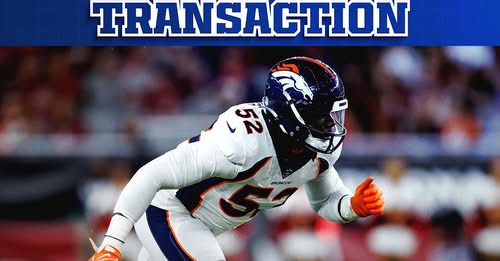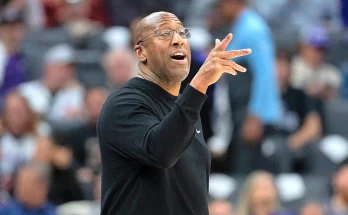The Indianapolis Colts have officially made a pair of significant roster moves that signal their intent to address both depth and performance as the NFL season progresses. The team announced the signing of free agent defensive end Marcus Haynes, while simultaneously placing wide receiver D.J. Montgomery on the Injured Reserve list. These changes highlight the organization’s ongoing efforts to fine-tune its roster, manage injuries, and position itself for competitiveness in a challenging AFC South landscape. Understanding the implications of these moves requires a closer examination of both players’ careers, the Colts’ current roster situation, and how these decisions might impact team dynamics on both sides of the ball.
Marcus Haynes, a defensive end with experience across several NFL teams, brings a combination of athleticism, versatility, and a strong motor that the Colts hope will energize their defensive front. Haynes went undrafted but has spent time with multiple franchises, gaining valuable experience in various defensive schemes. Known for his relentless pursuit of quarterbacks and ability to contribute in both run defense and pass rush situations, Haynes adds depth to a Colts defensive line that has shown flashes of brilliance but struggled with consistency. His signing represents a low-risk, high-reward strategy, as the team looks to bolster a defensive unit that is expected to face some of the league’s most potent offensive attacks this season.
Haynes’ arrival comes at a crucial time for the Colts. The defensive line has experienced injuries and inconsistency in recent weeks, leaving head coach and defensive staff searching for ways to rotate players effectively while maintaining high performance levels. The addition of Haynes not only strengthens the pass rush but also provides flexibility in defensive packages. His ability to play multiple positions along the defensive front allows the coaching staff to experiment with different alignments without sacrificing speed or aggressiveness. Moreover, his work ethic and previous stints with NFL teams indicate that he is well-versed in the demands of professional football, potentially allowing for a smoother transition into the Colts’ system.
On the other side of the roster, placing wide receiver D.J. Montgomery on Injured Reserve is a significant move that affects the offensive depth chart. Montgomery, who has been a dynamic presence when healthy, will now be sidelined for an extended period due to injury. This development forces the Colts to reassess their receiving corps and consider how to maintain offensive production without one of their key contributors. While Injured Reserve rules allow for a return later in the season, the immediate impact is the loss of a versatile playmaker capable of stretching the field and providing crucial yards after the catch.
Montgomery’s absence will likely prompt adjustments in the passing game. The Colts have several talented receivers, but losing a player with Montgomery’s skill set necessitates strategic shifts, both in play-calling and in targeting other receivers. Quarterback play will be particularly affected, as chemistry with receivers is built over time and relies heavily on consistent availability. Coaching staff will need to find ways to integrate other players more prominently into the game plan, whether by increasing targets for existing starters or exploring opportunities for younger, less experienced players to step into larger roles. Montgomery’s injury also highlights the importance of depth in the receiving corps, reminding teams that even mid-tier contributors can have a meaningful impact when injuries occur.
From a broader perspective, these roster moves underscore the Colts’ proactive approach to roster management. In today’s NFL, injuries are inevitable, and teams that can adapt quickly often gain a competitive advantage. By signing Haynes immediately and placing Montgomery on Injured Reserve without delay, the Colts demonstrate an understanding of the need for swift action to mitigate the impact of unforeseen circumstances. This approach not only preserves roster flexibility but also communicates to the team and fans that the organization is committed to maintaining competitiveness and addressing weaknesses as they arise.
Haynes’ integration into the Colts’ defense will be a key storyline in the coming weeks. Coaches will need to evaluate how his skill set complements existing defensive ends and interior linemen, as well as how he can be utilized in various packages to maximize pressure on opposing quarterbacks. His ability to generate sacks, disrupt plays in the backfield, and contribute in special teams could be particularly valuable in high-leverage situations. For a Colts defense that has occasionally struggled to consistently pressure the quarterback, Haynes’ presence might be the spark needed to elevate overall performance and create more turnover opportunities.
Meanwhile, Montgomery’s road to recovery will require careful management. Injuries to key receivers can have ripple effects throughout the offense, influencing game planning, red-zone efficiency, and overall offensive rhythm. The Colts’ medical and training staff will play a crucial role in monitoring his progress, ensuring that when he returns, he is fully healthy and capable of performing at a high level. This careful management is vital to prevent re-injury and to maximize Montgomery’s contributions later in the season.
The timing of these moves is also noteworthy. NFL teams often make roster adjustments in response to emerging challenges, whether they be injuries, underperformance, or matchup considerations. The Colts’ decision to sign Haynes now and place Montgomery on Injured Reserve reflects a strategic balancing act, addressing immediate needs while keeping an eye on long-term objectives. These moves signal a commitment to both offensive and defensive excellence, acknowledging that success in the NFL requires attention to all phases of the game.
Fan reaction to these roster changes is likely to be mixed but generally optimistic. Haynes’ signing brings hope for a more consistent and disruptive defensive line, while Montgomery’s injury understandably generates concern about offensive continuity. However, the Colts’ ability to adapt and find solutions to challenges has been a hallmark of their organizational culture. By making these moves decisively, the team reinforces confidence among supporters that it is actively managing its roster to contend in a competitive division.
In addition to the immediate impacts on the Colts’ roster, these moves also have broader implications for team culture and morale. Bringing in a motivated player like Haynes can energize the locker room, particularly among younger players who may benefit from his experience and work ethic. Conversely, managing Montgomery’s absence requires leadership from both coaching staff and veteran players to maintain focus and cohesion on offense. The ability of the team to navigate these changes effectively could influence performance in tight games and ultimately impact playoff positioning.
As the season unfolds, analysts and fans will closely monitor how these roster moves translate into on-field performance. Key metrics such as defensive pressure rates, quarterback sacks, offensive efficiency, and yards per reception will provide insight into the tangible effects of Haynes’ addition and Montgomery’s absence. These statistics will not only inform future roster decisions but also offer a window into the team’s adaptability, resilience, and depth.
Ultimately, the Colts’ recent roster moves reflect a calculated effort to strengthen weak points while managing unavoidable challenges. The signing of Marcus Haynes adds depth, talent, and versatility to the defensive line, potentially elevating the overall effectiveness of the Colts’ defense. Placing D.J. Montgomery on Injured Reserve, while unfortunate, is a necessary step to ensure his long-term health and the team’s compliance with roster regulations. Together, these decisions underscore the Colts’ proactive approach to roster management and their commitment to remaining competitive in a demanding NFL season.
These moves also highlight the dynamic nature of NFL roster construction, where teams must constantly evaluate talent, address injuries, and make strategic adjustments to achieve success. The Colts’ ability to navigate these challenges will play a significant role in determining their performance this season, influencing both immediate outcomes and long-term trajectory. As Marcus Haynes integrates into the defensive scheme and D.J. Montgomery works toward recovery, the Colts’ roster will continue to evolve, reflecting the ongoing balance between opportunity and adversity that defines professional football.
In conclusion, the Colts’ decision to sign Marcus Haynes while placing D.J. Montgomery on Injured Reserve represents a meaningful adjustment with implications for both the present and future. Haynes’ addition strengthens the defensive line and provides strategic flexibility, while Montgomery’s absence underscores the importance of depth and careful injury management. These moves exemplify the Colts’ proactive, forward-thinking approach to roster management, emphasizing adaptability, resilience, and competitiveness. As the season progresses, the impact of these decisions will be measured not only in statistics and wins but also in how effectively the team navigates challenges, maximizes opportunities, and maintains a culture of preparation and accountability. For fans, these moves offer both hope and perspective, illustrating the intricate considerations that shape an NFL roster and the ongoing pursuit of excellence that drives the Indianapolis Colts forward.


